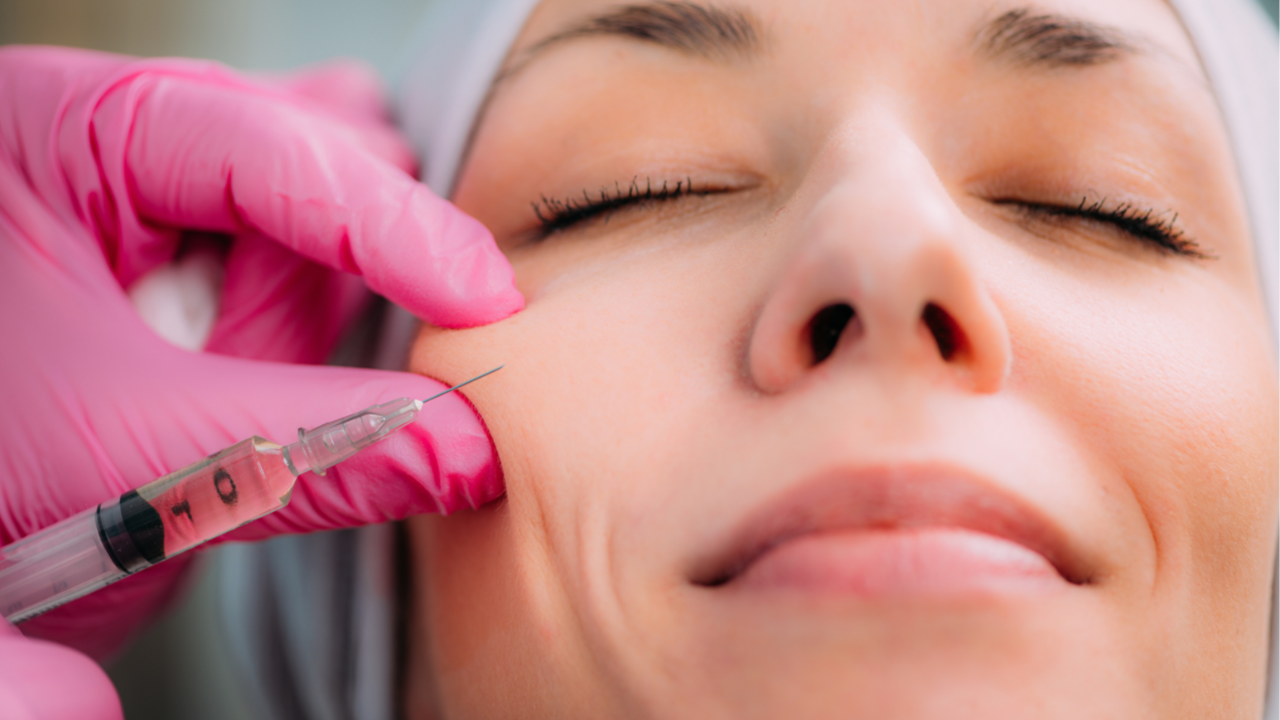Blog
Intervention May Be Necessary When Too Much Filler Is Used Under The Eye

The overfilling of tear troughs has become a common concern with the increasing number of individuals seeking nonsurgical tear trough fillers. Given the increase in the rate of tear trough filler treatment, it is a natural assumption that the incidence of ophthalmologic complications such as the Tyndall effect and overfilling have seen a proportional rise in occurrence. As we age, the under-eye area naturally becomes more sunken and hollow, often leading to a tired and aged appearance.
In an effort to combat this, patients and practitioners may overfill this delicate area, resulting in undesirable outcomes such as puffiness, swelling, or an unnatural look.
Hyaluronidase is a challenging enzyme to use as it requires finesse techniques to be used properly, especially for the periorbital regions. It has been utilized in both ophthalmology and aesthetic medicine for its specific and beneficial properties, including its rapid onset of effects, increased tissue permeability, breakdown of h...
Eyelash Lengtheners Serums Melt Pat Pads Under Eyes

There have been the latest trends of the use of prostaglandin analogues (PGA) lash lengthener serums to get those long thick voluminous lashes. In some cases, these lash lengthener products' ingredient list shows no mention of PGAs in the ingredient list. It was only identified on careful interrogation of the separate product information sheet. Because of this, these lash serums were not fully tested for safety and efficacy because of this discrepancy. Do you know the side effects of the lash lengthening serums?
What are PGAs?
PGA is a family of drugs, prescribed in eyedrop form, to provide efficient and stable control of intraocular pressure with relatively few side effects. and are now a popular antiglaucoma treatment. Many patients prescribed PGA eye drops noted lengthening, thickening, and darkening of their eyelashes. It has been long-established that these topical PGAs have a common side effect of periorbital volume loss. In other words, the fat pads under your eye are deterio...
Why Do Jowls Form and How to Treat Them?

Are you noticing the subtle signs of aging around your jawline? Perhaps you've started to notice the emergence of jowls, those pesky sagging skin folds that can contribute to a tired or aged appearance. Fortunately, advancements in aesthetic medicine offer innovative solutions to address this concern without the need for invasive surgery. One such solution gaining popularity is jowl treatment with dermal fillers—a non-surgical approach to rejuvenating and defining the jawline for a more youthful and refreshed look.
What causes jowling?
Before diving into the details of treatment for jowls, let's first understand what causes these bothersome facial features. Jowls typically develop due to a combination of factors, including age-related collagen loss, gravitational effects, and changes in facial fat distribution. As collagen and elastin fibers diminish with age, the skin loses its firmness and elasticity, leading to sagging and drooping along the jawline. Additionally, gravitational ...
Treatment of the Face Using Calcium Hydroxyapatite

Calcium hydroxyapatite (CaHa; Radiesse) is one of the most well studied dermal fillers worldwide and has been used to replenish lost facial volume and correct facial lines and folds. It's a must have product in every injectors practice due to its profound immediate and long-lasting effects in improving skin elasticity and laxity. Since its approval in 2006, Radiesse remains as the only FDA approved CaHA filler for facial augmentation and retains a well safety profile. Radiesse CaHA (+) is an opaque, semi solid, cohesive implant of 25-45μm CaHA microspheres suspended in a gel carrier of glycerin, sodium carboxymethylcellulose, 0.3% lidocaine hydrochloride, and sterile water. It is a semipermanent and biodegradable filler that is an effective stimulator of neocollagenesis in the face.
So what makes CaHA so unique?
Not only does CaHa filler restore volume loss almost immediately, but the injection stimulates a controlled inflammatory response that replaces the aqueous gel to a dense d...
Identifying Nodules

Nodules..., every injector's worst nightmare! A nodule is defined as growth of abnormal tissue developed underneath the skin. They often present as a large and hard lump that is very visible on the body in areas like the lips, cheek, jaw, etc. This can occur post injection as the nodules will appear soon after. There is nothing worse when you find them on a patient after you finish a dermal injection procedure.
Factors Leading to Nodule Formation
There are many causes that can lead to nodule formation. However, there are 3 main causes which include the properties of the hyaluronic acid tissue filler used, possible coexistent infection/colonization of pathogens, and the patient’s immune response. The plausible causes can include any of the following:
- Bolus size
- Pathogenicity of the implanted bacteria
- Body tolerating a normal skin commensal carriage
- Viremia or post vaccination immune response
- Implanted bacteria
- Age & Condition of Filler
- Activation of Toll-like receptors ...
Vertical Vectoring for Facial Lifting

Do you want to bring vertical vectoring to your practice?
In the past decade, minimally invasive aesthetic procedures have become more popular due to its low risk and fast recovery time. In 2020, providers performed more than 13 million minimally invasive cosmetic procedures in the U.S., which will only continue to grow in the future. Facial aesthetic procedures are highly requested among women to restore a youthful appearance and combat aging. Facial aging occurs in a three-dimensional manner and results in reduced collagen and elastin and reduced superficial and deep fat pads. Most of the changes observed during facial aging occur in the middle and lower face due to the effects of gravity, causing changes in volume and reduced overall facial support networks.
So what can you do?
Standard aesthetic procedures like surgical facelifts and facial thread lifting have traditionally been used to combat an aged appearance and descended facial tissue. Surgical facelifts can provide l...
Botox From Asia

Botox has been used to treat neuromuscular diseases and been a prevalent filler in the realm of aesthetic medicine for a long time. There have been so many companies developing their own neotoxin formula for botox injections available in the market, but which is the correct one to choose?
Typically, an injector should use a neurotoxin that is less immunogenic with highly purified toxins to obtain successful results for long-term repeated treatments. If there is a significant level of immunogenic response, this can lead to the formation of antibodies that can decrease the interaction between botox and presynaptic membrane binding sites. We want the interaction between botox and its presynaptic membrane binding site to have as little hindrance as possible so we can have the ideal results of relaxing the facial muscles, reducing wrinkles or frown lines.
New Toxin Formulations from Asia
New toxin formulations have recently emerged in Asia that created hype around these products. The...
Ischemic Complications

Ischemic complications. Two simple words that can make even the most seasoned injector quake in their Crocs. Ischemic complications are defined as an unintended impediment to normal blood flow during placement of dermal fillers. These complications are widely regarded as the most serious and require immediate intervention. The effects of these complications can include ophthalmoplegia, cerebral infarction, vision loss, and necrosis. In the case of vision loss, it is possible that symptoms may be irreversible with little to no evidence of symptom improvement. Some studies have determined that the rate of ischemic complications is around 3 injections per 1,000 performed globally.
The temples are one of the most complicated treatment areas of the face. They possess a highly complex vascular arrangement as well as multiple distinct layers of tissue that require an injector’s treatment plan to be precise and thorough. The main vascular features to take into account when performing a te...
Myomodulation and Injectable Fillers

Facial filler philosophy has been characterized by an overwhelming focus on skin and fat as opposed to muscle action. When it comes to facial aesthetics, injectors will often focus on static wrinkles and volume loss rather than muscle interaction. Hyperactive muscles are commonly addressed by neuromodulators like botulinum and other toxins; for example, masseter hyperplasia may be treated with botulinum. However, a Brazilian study by Mauricio de Maio identified a link between injectable fillers and muscle movement, or myomodulation. Let’s take a look at the findings:
Myomodulation & Biomechanics: How our faces move
Facial muscles, or mimetic muscles, are in charge of facial expression. Three key aspects dictate such muscle movement:
- Length-Tension Relationship
- Muscle Pulley and Lever Systems
- Functional Muscle Groups
Length-Tension Relationship
The length-tension relationship is dictated by two components: contractile and elastic.
The contractile component reli...
Hyaluronidases and Dissolving Filler

Natural looks are trending, and as more people open up about getting injectables, many are reversing the effects of their fillers. While injections may fade over time, hyaluronidases can help speed up the process.
What are hyaluronidases?
Hyaluronidases are a family of enzymes that break down hyaluronic acid (HA). The body degrades HA via thermal pathways, free radicals, and naturally occurring hyaluronidases. While these natural processes will help dissolve the filler over time, patients finding complications with their treatment may look for alternative methods of dissolution.
When to get hyaluronidase injections
Adverse effects and complications from hyaluronic acid fillers may include the following:
- Cosmetic overcorrection
- Inflammatory nodules
- Delayed onset nodules
- Vascular occlusion
- Blindness
- Tyndall effect
- Allergic or immunogenic reaction to HA filler
- Necrosis
Each of these occurrences may prompt patients to seek correction via hyaluronidase. Unless the...


